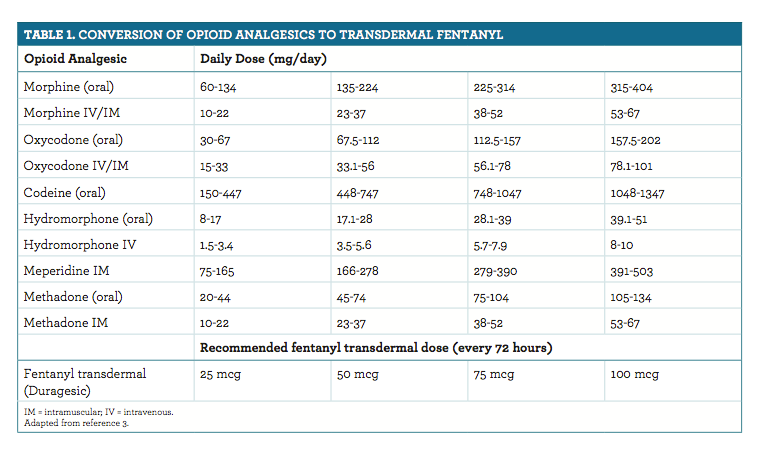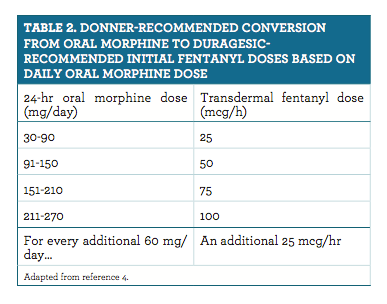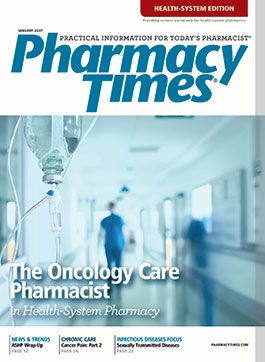Advanced Breast Cancer
LJ is a 75-year-old patient with advanced breast cancer. She also has a medical history of hypertension and dementia. LJ decided to stop chemotherapy 2 months ago due to severe nausea, vomiting, and diarrhea.

LJ is a 75-year-old patient with advanced breast cancer. She also has a medical history of hypertension and dementia. LJ decided to stop chemotherapy 2 months ago due to severe nausea, vomiting, and diarrhea. The nausea and vomiting have ceased, but she still has occasional diarrhea. LJ has lost 50 lb in the past 6 months but has no problems swallowing and recently regained some weight. She is bed bound, alert, and oriented ×1. Her family has decided to put her on hospice services.
LJ rates her pain level as an 8 on a 10-point scale. She takes a breakthrough pain medication, but her family reports that it only seems to “help a little bit and does not last very long.” LJ says the pain is centered in the middle of her back, and she appears to be uncomfortable, especially with any kind of movement. The hospice team would like to simplify her medication regimen and gain control of her pain.
LJ weighs 180 lb and had a blood pressure of 160/80 mm Hg this morning. Her medications are as follows:
• Lisinopril 10 mg, 1 tablet by mouth daily
• Donepezil 10 mg, 1 tablet by mouth daily
• Fentanyl patch 50 mcg, 1 patch every 3 days
• Oxycodone 5 mg, 1 tablet by mouth every 4 hours, as needed, for breakthrough pain; LJ does not know how many doses she has taken
• Long-acting morphine 15 mg, 1 tablet by mouth every 12 hours
Discussion
Pain is common but not necessarily present in individuals with cancer. Pain can be caused by cancer itself or, in some cases, by medical intervention and treatment. Approximately 24% to 60% of patients with cancer experience pain while undergoing treatment, and 62% to 86% with advanced cancer experience pain.1
Breast cancer can spread to lymph nodes, muscle, fatty tissue and skin, bone, bone marrow, the liver, the lungs, and the brain. The most common sites of bone metastasis with breast cancer include the ribs, spine, pelvis, and long bones of the arms and legs.2 Patients often describe bone pain as dull and/or achy, and it can worsen with movement. Spinal cord compression can be a complication of bone metastasis. Bone pain can be treated with nonsteroidal anti-inflammatory drugs, corticosteroids, bisphosphonates, denosumab, and radiation.
It would be appropriate to start LJ on a steroid to treat probable bone metastasis and possible spinal cord compression. Her medical team chose to start dexamethasone at a dose of 4 mg/day and to monitor her pain control.
Only 1 long-acting opioid should be used at a time. LJ was treated with a fentanyl patch and long-acting morphine, which is a duplication of therapy. To resolve this, 3 options are available:
1. Convert the morphine to an equivalent fentanyl dose, and increase the dose of the fentanyl patch.
2. Convert the fentanyl patch to an equivalent morphine dose, and administer morphine around the clock.
3. Convert the narcotic dosages to an equivalent oxycodone dose, and use oxycodone immediate-release around the clock.
Option 1
For increasing the dose of the fentanyl patch, several dosing guides are available for converting morphine to fentanyl. The package insert offers a conversion table (table 13) and states that 50% of patients require an upward dose titration based on this table. Therefore, other researchers have developed another dosing chart that is not as conservative (table 24). Breitbart and colleagues popularized another option, which offers the following process for opioid conversion to transdermal fentanyl patches5:
1. Determine the total daily dose of oral morphine required to control the patient’s pain (or the equivalent based on the current opioid regimen).
2. Use a conversion of 2:1 (milligrams of oral morphine per day to micrograms/hour of total daily fentanyl) to calculate the micrograms/hour dose of fentanyl.
Besides the different conversion strategies, another major drawback to fentanyl patches is that they are available in only set doses. Caution must be used when titrating fentanyl up or down and in elderly patients.

In LJ’s case, the recommendation per table 1 would be to stop the long-acting morphine and not increase the fentanyl patch dose. Table 1 does not indicate that a fentanyl patch is enough to provide 30 mg of morphine. Per table 2, 30 mg of morphine is equivalent to a 25-mcg patch. Therefore, a 25-mcg patch could then be placed in addition to the 50-mcg patch, for a total of 75 mcg every 72 hours.
Using the method of Breitbart et al, 30 mg of morphine equals 15 mcg of fentanyl. Because a 15-mcg fentanyl patch is not manufactured, a 12-mcg patch every 72 hours would suffice. I would recommend this method of pain management because the patient is elderly and is experiencing pain despite her current medications.
Option 2
Convert the fentanyl dose to an equivalent morphine dose. The patient is using a 50-mcg fentanyl patch, which equals approximately 100 mg of morphine (using the conversion of 1 mcg of fentanyl to 2 mg of morphine). Add the additional 30 mg of morphine per day that LJ is already receiving, bringing the dose to 130 mg of morphine per day. Divide this by 2 to get a dose of 65 mg of long-acting morphine every 12 hours. Because long-acting morphine does not come in a 65-mg tablet, the dose can be rounded down to 60 mg of long-acting morphine every 12 hours.
Option 3
Because the patient uses oxycodone immediate-release tablets as a breakthrough pain medication, the pain medications could be converted to oxycodone immediate-release around the clock and, as needed, for breakthrough pain. However, having to deliver the pain medication every 4 hours around the clock may be burdensome to the family and patient. Because the patient is able to swallow and use a long-acting formulation, option 3 may not be the best choice.
The hospice team chose to change LJ to long-acting morphine 60 mg every 12 hours. This is the most cost-effective option and easy for her family to administer. This dose can easily be converted to morphine immediate-release around the clock if the patient can no longer swallow the long-acting product, or it can be given rectally.
The team also chose to change the patient’s breakthrough medication to morphine liquid concentrate (100 mg/5 mL), allowing the team to quickly titrate the long-acting medication based on the total amount of breakthrough doses the patient takes every 24 hours. The family and patient were counseled to record each breakthrough dose given in order to monitor LJ’s pain control. The typical breakthrough dose is 10% to 20% of the total daily morphine dose. LJ is taking 120 mg of morphine per day; the appropriate breakthrough dose range is 12 to 24 mg of morphine every 4 hours, as needed. The team chose to give LJ 15 mg of morphine every 4 hours, as needed.
LJ’s blood pressure is elevated, possibly due to pain. The team chose to monitor her blood pressure. If it remains elevated after pain control, the lisinopril dose could be increased.
The team talked to the family about possibly discontinuing donepezil because LJ is bed bound, is at the end stage of breast cancer, and has moderate to severe dementia. At this stage, the donepezil is probably having a minimal impact on her dementia, and this drug is known to cause diarrhea due to its cholinergic effects; therefore, discontinuing donepezil could help improve the diarrhea. The family agreed to discontinue donepezil, and the team will continue to monitor for diarrhea and constipation, as well as start a bowel regimen, if needed. LJ’s new medication regimen follows:
• Lisinopril 10 mg, 1 tablet by mouth daily
• Dexamethasone 4 mg, 1 tablet by mouth every day
• Long-acting morphine 60 mg, 1 tablet every 12 hours
• Morphine 100 mg/5 mL, 0.75 mL (15 mg) by mouth every 4 hours, as needed

The team returns 3 days later to see how LJ is doing. She reports her pain level is down to a 5 out of 10 and does not appear to be in as much distress. She reports still having dull achy pain in her back, with more pain upon movement, but no numbness, tingling, or burning. The family reports the use of 3 to 4 breakthrough doses of morphine per day. The team decides to increase LJ’s dexamethasone dose to 4 mg at breakfast and lunch for what appears to be bone pain and to reassess it in 3 days.
Three days later, LJ reports that her pain is down to a 3 out of 10, which allows her to be comfortable. The family reports no more than 2 breakthrough doses of morphine per day. LJ appears to be comfortable. She and her family say her pain is being controlled with her regimen, and they do not wish for further adjustment at this time.
Michelle Smith, PharmD, BCPS, CPE, received her degree from the University of Wyoming School of Pharmacy and completed a residency at Thomas Jefferson University Hospital. She has experience in geriatrics, medication therapy management, hospice, and medical writing.
References:
- van den Beuken-van Everdingen MH, de Rijke JM, Kessels AG, Schouten HC, van Kleef M, Patijn J. Prevalence of pain in patients with cancer: a systematic review of the past 40 years. Ann Oncol. 2007;18(9):1437-1449.
- National Breast Cancer Foundation (NBCF). Metastatic breast cancer. NBCF website. nationalbreastcancer.org/metastatic-breast-cancer. Accessed September 30, 2016.
- Duragesic [package insert]. Moutain View, CA: Alza Corporation; 2003.
- Donner B, Zenz M, Tryba M, Strumpf M. Direct conversion from oral morphine to transdermal fentanyl: a multicenter study in patients with cancer pain. Pain. 1996;64(3):527-534.
- Breitbart W, Chandler S, Eagel B, et al. An alternative algorithm for dosing transdermal fentanyl for cancer-related pain. Oncology (Williston Park). 2000;14(5):695-705; discussion 705, 709-717.

